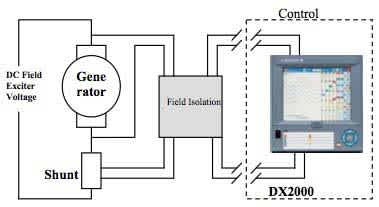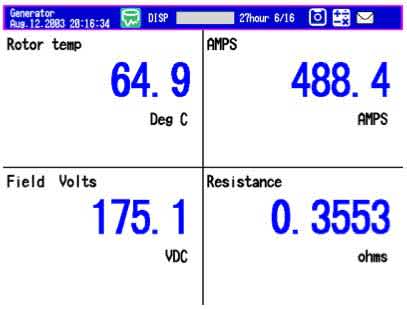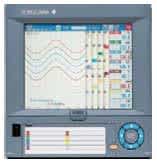Introduction
A major power company in the Southern part of the United States needed a solution for monitoring Generator Field Winding Temperature.
Application
 |
| Generator Field Temperature Monitoring |
Field temperature monitoring systems use DC to DC isolation amps to present exciter volts and shunts amps to a computing module that in turn sends a voltage or milliamp signal representative of the field temperature to a recording or indicating device.
Generator Field Winding Temperature can be obtained by combining two independent basic measurements consisting of the resistance of a conductor as a function of temperature and the resistance of a conductor as a function of the voltage and current through the conductor. The resistance of the field at the operating temperature can be determined by measuring the voltage impressed on the field by the generator exciter and the resulting DC current through the field as a result of the exciter voltage. Since these relationships independently determine the field winding resistance, by combining the ohms law relation with the properties of the material relation an operating temperature can be determined using the actual field voltage and shunt current.
The generator field is the rotating magnet of the generator. This rotating magnetic field induces a voltage in the stationary stator winding of the field converting the shaft mechanical work from the steam turbine or other prime mover into AC electrical power.
The rotation of the field requires a slip ring and brush assembly to transfer the DX current into the rotation field rotor. The voltage drop across the brushes is a voltage loss and will cause an error in the temperature calculation. The brush drop is subtracted from the measured field voltage to determine the actual applied voltage to the field winding.
The field current is measured using a calibrated shunt. The DC voltage drop across the shunt is proportional to the actual field amperes.
Solution

The DXAdvanced paperless recorder computes the Field Temperature based on generator inputs from Juxta DC to DC isolation amps mounted near the generator for the exciter voltage and shunt amps.
Operators can view amps, DC field volts, rotor temperature, rotor resistance and/or load. The DXAdvanced provides:
- Digital calculations for improved accuracy
- Alarm indication and output relays
- Adjustable noise filter
- Brush drop compensation
- Easy upgrade from old monitoring system
- Ability to replace or use existing isolation amps
Generator data plate information supplied by the Generator Manufacturer is used to perform custom calculations specific for each generator. These parameters are:
Brush Drop ________________________________
Shunt Amp Rating ___________________________
Shunt mV _________________________________
Unit Reference Resistance_____________________
Rotor Resistance at Ref. Resistance _____________
Temperature Coefficient of Rotor ________________
Reference Temperature _______________________
Include at least one generator calibration data point.
Yokogawa's DXAdvanced Paperless Recorder solution using field mounted Juxta isolators is a replacement for all manufacturers' generator field temperature units including Leeds & Northrup Generator Field Temperature Measurement models for both the control room recorder and the field mounted unit.

Equipment used for the application:
- DXAdvanced Paperless recorder with math
- See Bulletin 04L41B01-01E for more information - Juxta Isolation Amplifiers
Part number VJH1-016-24NO for shunt mV input and part number VJH1-016-44NO/Z (Z=Range of Exciter voltage). Note: If exciter voltage exceeds 300 VDC also use FVDV- 11*B voltage divider and change Juxta part number. See GS77J01H01-01E for more technical information about the Juxta VJH1 series. - Cabinet for mounting Juxta Isolation Amps
Related Industries
-
Power Generation
Since the 1970s, Yokogawa has partnered with power producers to squeeze every watt of efficiency and resilience from assets old and new. Today our 30,000+ CENTUM control systems and 230 service hubs span 100 countries, uniting domain know‑how, ISASecure™‑certified automation, and real‑time analytics. Whether you run a single gas turbine or a continent‑wide renewable fleet, we deliver the insight, safety, and speed you need to thrive in a decarbonizing grid.
Have Questions?
Contact a Yokogawa Expert to learn how we can help you solve your challenges.